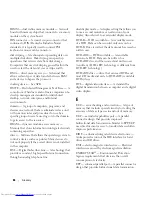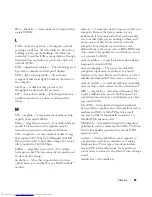
74
Glossary
video memory — Memory that consists of memory
chips dedicated to video functions. Video memory is
usually faster than system memory. The amount of
video memory installed primarily influences the
number of colors that a program can display.
video mode — A mode that describes how text and
graphics are displayed on a monitor. Graphics-based
software, such as Windows operating systems,
displays in video modes that can be defined as x
horizontal pixels by y vertical pixels by z colors.
Character-based software, such as text editors,
displays in video modes that can be defined as x
columns by y rows of characters.
video resolution — See resolution.
virus — A program that is designed to inconvenience
you or to destroy data stored on your computer. A
virus program moves from one computer to another
through an infected disk, software downloaded from
the Internet, or e-mail attachments. When an
infected program starts, its embedded virus also
starts.
V — volt — The measurement of electric potential or
electromotive force. One V appears across a resistance
of 1 ohm when a current of 1 ampere flows through
that resistance.
W
W — watt — The measurement of electrical power.
One W is 1 ampere of current flowing at 1 volt.
WHr — watt-hour — A unit of measure commonly
used to indicate the approximate capacity of a
battery. For example, a 66-WHr battery can supply 66
W of power for 1 hour or 33 W for 2 hours.
wallpaper — The background pattern or picture on
the Windows desktop. Change your wallpaper
through the Windows Control Panel. You can also
scan in your favorite picture and make it wallpaper.
WLAN — wireless local area network. A series of
interconnected computers that communicate with
each other over the air waves using access points or
wireless routers to provide Internet access.
write-protected — Files or media that cannot be
changed. Use write-protection when you want to
protect data from being changed or destroyed. To
write-protect a 3.5-inch floppy disk, slide its write-
protect tab to the open position.
WWAN — wireless wide area network. A wireless
highspeed data network using cellular technology and
covering a much larger geographic area than WLAN.
WXGA — wide-aspect extended graphics array — A
video standard for video cards and controllers that
supports resolutions up to 1280 x 800.
X
XGA — extended graphics array — A video standard
for video cards and controllers that supports
resolutions up to 1024 x 768.
Z
ZIF — zero insertion force — A type of socket or
connector that allows a computer chip to be installed
or removed with no stress applied to either the chip or
its socket.
Zip — A popular data compression format. Files that
have been compressed with the Zip format are called
Zip files and usually have a filename extension of .zip.
A special kind of zipped file is a self-extracting file,
which has a filename extension of .exe. You can unzip
a self-extracting file by double-clicking it.
Zip drive — A high-capacity floppy drive developed
by Iomega Corporation that uses 3.5-inch removable
disks called Zip disks. Zip disks are slightly larger than
regular floppy disks, about twice as thick, and hold up
to 100 MB of data.




































